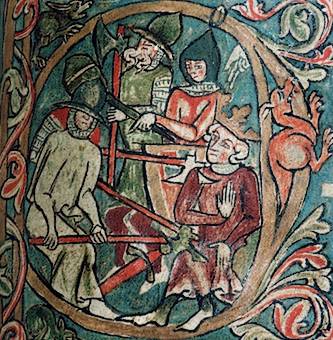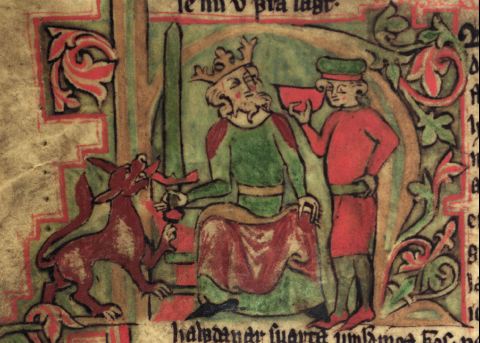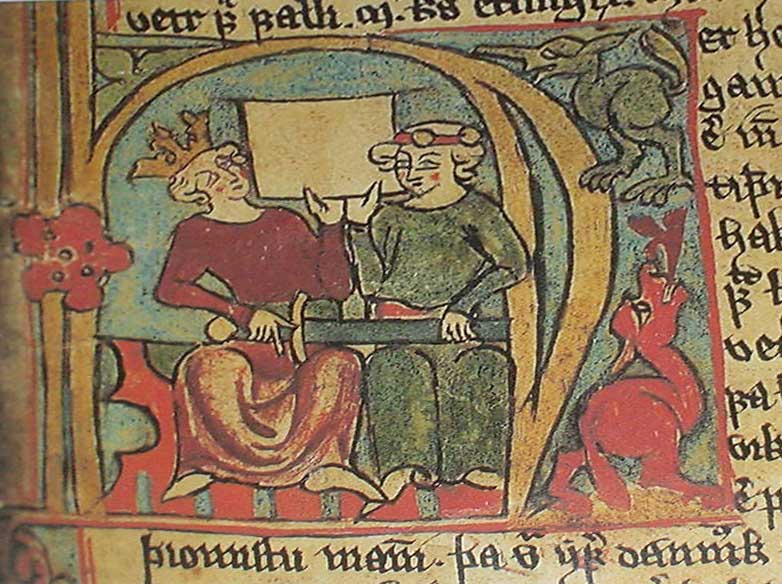


 |
 |
 |
This page is not designed to teach you the language of the vikings, conventionally called nowadays Old Norse (or Old-Norse–Icelandic). For that, you will have to go elsewhere. (Another site, geared to linguistics students, is available from the University of Texas at Austin; thanks to Laura Hart for the reference. Here you can find, among other things, a reading from Egils saga cap. 60.) Better yet, sign up for a sequence taught every year out of Cornell's Linguistics Department, LING 3315 (Fall) & 3316 (Spring). NB: the instructor, Linda Heimisdóttir, is a native speaker of Icelandic as well as a scholar of Old Norse. (Cornell used to offer courses in Swedish for those more inclined to pick up a living language you can actually use to communicate with people. Unfortunately, we lost the Swedish program to budget cuts in 2008-9. Maybe someday...)
The purpose of this page is to help you out with some basics of pronunciation, orthography, and frequently encountered features of the language. Modern Scandinavian languages are also addressed in passing.
In general, if you pronounce ON more like German than like American English, you will probably get at least some of it right some of the time. And even if you don't, you'll still make a mighty impression on your friends and family.
| Old Norse ... | is pronounced more or less like ... |
| Þ þ | MnE thin |
| Ð ð | MnE there |
| J j | MnE yes |
| ll, rl (as in the names Egill, Sturla) | tl (as in: Eh-yitl, Stut-la) |
| fn (as in the word hrafn, raven) | ppn (as in: [h]rappn) n represents here a slight nasal exhalation, as in Fr Jean or Portuguese João |
| dd (as in the name Oddi) | ht (as in: Awh-ti) |
| Ó ó | MnE slow |
| Ú ú | MnE cool |
| Í í | MnE ear |
| É é | MnE yell |
| Á á | MnE house |
| Æ æ, Œ œ | MnE wine |
| Ø ø, Ö ö, Ǫ ǫ | MnE fur, German öffentlich |
| Y y | German Stück (short) |
| Ý ý | German Glüh (long), Fr déjà vu |
| Au au | Fr oeil, German öj |
| Modern Scandinavian ... | is pronounced more or less like ... |
| G g, Gj gj + vowel (esp. e, i, y, ä, æ) | MnE yes (e.g. Sw Gällivare ~ yeh-li-vah-reh) |
| K k, Kj kj + vowel (esp. e, i, y, ä, æ) | German Ich, MnE sharp (e.g. Sw Kaupang ~ chow-pung) |
| Æ æ, Ä ä | MnE frat, sank |
| Å å, Aa aa | MnE awe |
| Ø ø, Ö ö, Œ œ | MnE fur, German öffentlich |
| Sw O, o | MnE cool |
Nouns (including proper names), pronouns and adjectives in ON have genders (masculine, feminine, neuter) and change their form slightly according to their function in a sentence (just like in English, the first-person pronoun has the form I when it is performing an action, me when it has an action performed on it, my when it is used to indicate possession: "I paid you the money, but you didn't give me my new Rolls Royce"). There are only two basic features here which it is worthwhile keeping in mind:
1. The 'default' endings of nouns, pronouns and adjectives are often -r, -i, -a, or a doubled consonant (-nn, -ll, etc.): fjörðr, Gísli, saga, Sveinn, Egill. Translators sometimes choose to retain these default endings, sometimes drop them. Thus you will find the protagonist of Egils saga referred to in some translations as Egill and in others as Egil. Make sure you keep track of identical terms (including names) which may appear in slightly different forms in different translations: Sveinn, Svein, Svend, and even Sweyn and Swegen may all be the same person.
Keep in mind, when working with translations, that different translators may decide to simplify Norse pronunciation in various ways: þ becomes th, ð becomes th or d (or sometimes dh), meaningful parts of compound names are sometimes translated and sometimes left in their original (or simplified original) form, etc. Thus, for instance, the place-name Laxárdalr may be rendered as Laxardal or Laxar Dale or Trout-River Valley or any combination of those elements. Similarly, Þórgerðr and Thorgerd reflect different orthographic decisions on how to render the same woman's name.
An added difficulty stems from the fact that some words, especially proper names, have long-standing traditional renditions into English, or are translated into English via a modern Scandinavian language, resulting in further variations of form. The name Knútr, for example, may be given as Knut (or, following the Danish spelling, sometimes Knud), but because a Danish-born king Knútr ruled over England in the early 11thC, English sources have a long tradition of referring to him in an anglicised form, Cnut or Canute. Likewise, the name Óláfr might be rendered as Ólafur (MnIce), Olaf (Norw), Olav (Da), Olof (Sw), not to mention forms like Anlaf (medieval Irish). Finally, where an English cognate or borrowing exists, it may be substituted for the Norse form: the ON word fjörðr, for example, is the ultimate source for the MnEng fjord, so some translators may choose to make a place-name like Vápnafjörðr into Vápnafjord or even Weapons' Fjord.
2. Like English, ON indicates the possessive by altering the ending of words. Possessive endings include -s (without an apostrophe), -ar, -a, or -u: Egils, fjarðar, Gísla, sögu. (You may have noticed that other parts of the word, besides its ending, also sometimes change: fjörðr > fjarðar, saga > sögu. You needn't worry about those.) It's worth remembering these possessive endings because they help make sense of compound words or word strings: when you see a text entitled Gísla saga , for example, you'll know that it's the saga of a character named Gísli; a place called Vápnafjörðr becomes transparent as the fjord of vápn, that is, weapons; etc. .
The possessive can be especially helpful in figuring out the family relations of characters you encounter in the sagas and elsewhere. Medieval Scandinavians (and present-day Icelanders) did not use fixed surnames. Instead they used patronyms, i.e. a child was known as X son/daughter of Y. Knowledge of the ON possessive endings makes these names transparent to English speakers: Egill Skalla-Grímsson, for instance, is Egill the son of Skalla-Grímr; Halgerðr Snorradóttir is Halgerðr, the daughter of Snorri; and so on.
return to HIS 3200 syllabus
Oren Falk, Associate Professor
Department of History, Cornell University
Page last updated on: 7 February, 2012